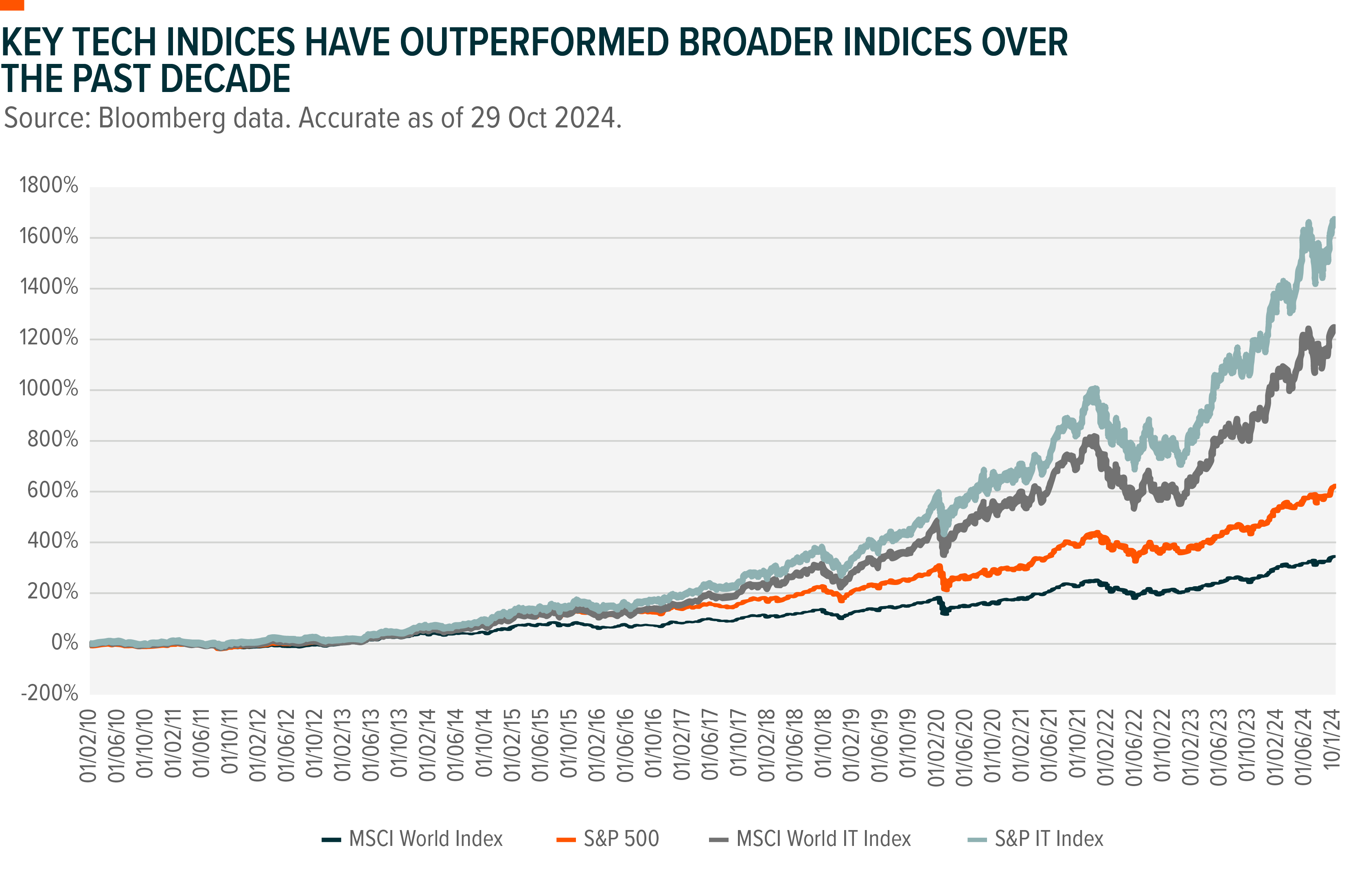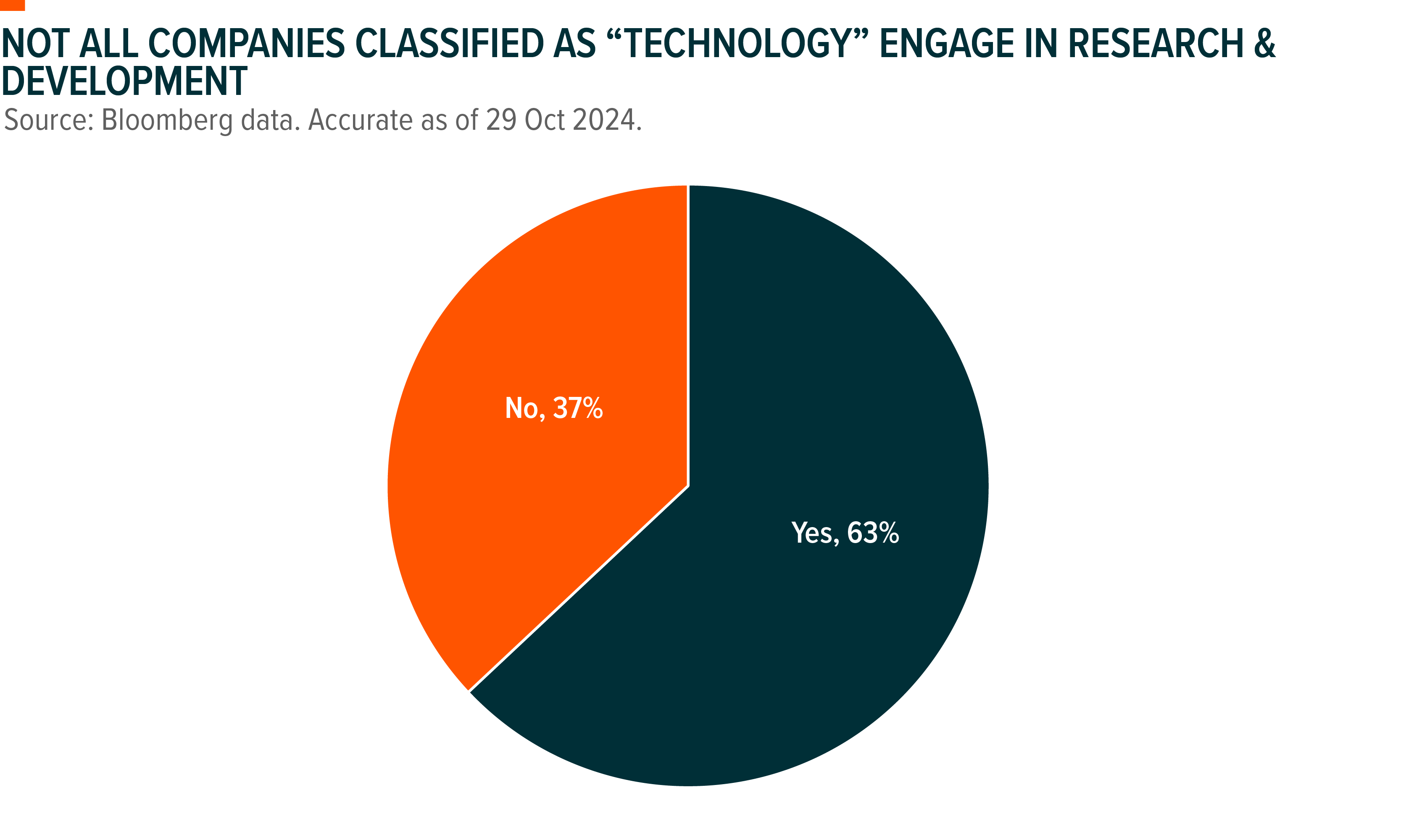Uncovering the broader landscape of innovation
Innovation isn’t just a buzzword; it’s the lifeblood of growth, competitiveness, and sustainability across industries. Companies that consistently push boundaries – those that innovate rather than merely adapt are the ones most likely to thrive, transforming technological advances into real-world progress. This drive has been central to the sustained outperformance of technology (“tech”) indices, such as the MSCI World Information Technology Index and S&P 500 Information Technology Sector Index, which have exceeded broader market benchmarks over the past decade.(1) In an era where disruption is constant, companies at the forefront of innovation often find themselves leading the charge, no matter their sector or exchange.
Key takeaways
- The Nasdaq remains a vital hub for tech innovation, yet many pioneering companies have also emerged on other exchanges. In the US, around 40% of tech stocks by number and 20% by market weight are primarily listed outside of Nasdaq(2), reflecting the diverse landscape where innovation flourishes.
- Year to date, Nasdaq-listed tech stocks posted a 57% total return, while non-Nasdaq tech names followed closely with 43%, underscoring that significant growth opportunities also exist outside Nasdaq.(3)
- Companies across multiple sectors are adopting tech solutions, yet only 63% of those classified under traditional technology classifications report dedicated R&D spending.(4) This highlights the importance of looking beyond labels to find companies genuinely committed to transformative growth.

A broader view on innovation
The Nasdaq has long been viewed as a foundational home for technology and innovation, with listing requirements from market capitalisation to governance adding a layer of prestige. Yet, not all industry leaders are listed there. Legacy players like IBM and Oracle, as well as newer tech giants like Salesforce and ServiceNow, have established themselves on exchanges outside Nasdaq, reflecting their unique business paths and longstanding exchange commitments. This mix of longstanding and emerging leaders demonstrates that innovation is not bound to one exchange but is inherently diverse and widely distributed.
Recent performance data supports this perspective. While Nasdaq-listed tech companies achieved a 57% return over the past year, non-Nasdaq tech names delivered 43% return, indicating that compelling growth stories are unfolding across different platforms. Approximately 40% of US tech companies, representing 20% of the tech sector’s market weight(5), are listed outside the Nasdaq, revealing the breadth of groundbreaking ideas across multiple venues.

Innovation Beyond Traditional Tech Labels
Innovation has also moved beyond traditional tech companies. Sectors such as healthcare, energy, and consumer goods are adopting and developing new technologies, from AI-driven health diagnostics to renewable energy solutions. The line between tech and non-tech continues to blur as companies across various industries embrace transformative change.
Historical data reveals how the sectors that make up the top 20 companies in the S&P 500 have shifted dramatically over the last two decades, illustrating how technology’s influence has permeated previously “non-tech” fields. For investors, recognising these sector shifts is crucial. It’s no longer enough to rely solely on tech labels; it’s essential to seek out companies truly driving change, regardless of classification.
Yet, even as innovation spreads, it’s essential to distinguish those truly committed to technological advancement. Only around 63% of companies classified as tech by traditional metrics report a dedicated R&D budget. The remaining companies may carry the tech label, but their contributions to technological progress remain unclear. For investors, this makes it increasingly important to look beyond labels and focus on firms actively investing in future growth.

Case studies: Motorola Solutions and Thomson Reuters
Two key innovators listed outside Nasdaq, Motorola Solutions and Thomson Reuters, demonstrate how transformative technology is driving growth beyond traditional “tech” labels:
Motorola Solutions (NASDAQ: MSI): Evolving from its telecommunications roots, Motorola Solutions now focuses on advanced public safety technology. It leverages AI for video analytics, cybersecurity, and real-time emergency communication, supporting critical response teams with situational awareness and secure data solutions.
Thomson Reuters (NASDAQ: TRI): Renowned in legal and financial information services, Thomson Reuters integrates AI and data analytics to enhance workflows for professionals in law, finance, and tax. With tools like CoCounsel Core and Practical Law AI, it streamlines research, document drafting, and compliance, setting a new standard in professional services.
These examples show that innovation flourishes across diverse industries, encouraging investors to look beyond typical tech sectors and Nasdaq listings to identify true pioneers in transformative technology.

Implications for investors
In today’s globalised market, innovation is everywhere, spanning across regions and industries. While Nasdaq remains a vital hub, compelling opportunities extend well beyond it. By seeking out companies truly committed to innovation regardless of whether they carry the “tech” label investors can position themselves for growth that reflects the dynamic nature of innovation. The Global X US 100 ETF (U100) aligns with this approach, offering investors a gateway to a broad selection of transformative companies. This accelerating pace of progress proves that impactful ideas can thrive across markets, making it essential to recognise that the next wave of innovation may come from any corner of the market.
Related funds
The Global X US 100 ETF (ASX: U100) invests in 100 of the largest innovative companies listed on the US market on either the NASDAQ or NYSE. It focuses on technology and pioneering US companies, providing investors to sectors with higher potential growth.

3 stocks mentioned
1 fund mentioned

